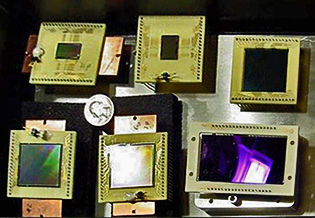Research at Lick Observatory
 CCDs fabricated in the UCO Detector Lab. Telescope cameras and spectrometers use CCDs to detect and record photons of light during observations.
CCDs fabricated in the UCO Detector Lab. Telescope cameras and spectrometers use CCDs to detect and record photons of light during observations.
Search for Low-Mass Companion Stars
UCO/Lick astronomers are searching for brown dwarfs and other low-mass companions to known stars. These stars are too small and dim to be imaged using conventional cameras, which rely on visible light. Because of the development of the Gemini Infrared Imaging Camera, built at the UCLA Infrared Imaging Detector Lab, low-mass companions have recently been observed for the first time.
Since the new field of infrared observation reduces interference from both ground-based light pollution and cosmic dust, the Gemini IR Imaging Camera is also useful for many other types of current and future research.
Distant Radio Galaxies
Astronomers have detected the presence of very distant and massive galaxies, which emit large amounts of radio waves, by studying spectra produced by the Kast spectrograph. These are thought to be galaxies at early stages of evolution. Astronomers study these galaxies to determine the source of their radio emissions and to understand evolution of very massive galaxies.
Massive Intergalactic Hydrogen Clouds
Lick astronomers observe very distant clouds of intergalactic hydrogen. These clouds are as massive as galaxies, but unlike galaxies have no luminosity, so their spectra cannot be recorded directly.
Astronomers study these hydrogen clouds indirectly using quasars. Quasars are very remote sources of radiation. When the light emitted by a quasar passes through a massive hydrogen cloud before reaching Earth, the hydrogen cloud absorbs certain wavelengths of light, producing a spectrum that can be studied.
Astronomers believe that massive hydrogen clouds are very young progenitors of various types of galaxies, which show a picture of early star formation and chemical evolution.
Both the Kast and Hamilton spectrographs are used in this research. The Kast is used to identify quasars beyond massive hydrogen clouds. The Hamilton is used to study absorption lines in the quasars' spectra.
Optical Search for Extraterrestrial Intelligence
Using a triple photometer on the Nickel telescope, OSETI astronomers look for evidence of artificially-produced bursts of light which might indicate extraterrestrial intelligence. Only one billionth of a second in duration, these light bursts would be created by other civilizations explicitly to signal distant intelligent life. All visible wavelengths are monitored. Three beams are recorded simultaneously to virtually eliminate false positive signals due to interference such as a cosmic ray or atmospheric instability.
In conjunction with observatories throughout the world, Lick OSETI researchers target all stars with a presumed lifetime long enough to allow evolution of complex life.
No lasers have been detected to date; we will report findings here should ET signal us.
Search for Extrasolar Planets
Lick Observatory is a leader in the search for planets outside our solar system. Too tiny and distant to be seen directly, these planets are detected when their gravity affects the velocity of their parent star, causing the star to "wobble" in a regularly repeating pattern. UCO planet hunters have detected such wobbles as small as 1.0 m/second, equivalent to walking speed.
Lick astronomers monitor about 1000 stars similar to the sun in luminosity, surface temperature, and evolutionary stage. Many Jupiter-size and Saturn-size planets have been discovered. As technology improves, smaller planets will be discovered more frequently. The ultimate goal of extrasolar planet search is to discover a solar system similar to our own with earth-like planets that may support life. So far only one such planet has been found.
The Shane telescope and the Hamilton spectrograph are currently used to hunt for planets. The new Automated Planet Finder (APF) telescope and spectrograph is in the process of being commissioned on Mt. Hamilton. This telescope will search robotically for extrasolar planets every night.
Chemical Composition & Evolution of Stars & Galaxies
Since the early 1980s, Lick Observatory has been well known for research on chemical compositions of stars within our Milky Way galaxy. Astronomers observe properties of stars in various stages of their evolution, piecing together pictures of how both stars and galaxies evolve chemically.
Astronomers are particularly interested in nucleosynthesis: how elements are created in stars. They want to know exactly how a star, which starts out as mostly hydrogen, becomes rich in metals and other elements over time.
Two research methods are employed. The first is analogous to an archeological dig. Astronomers observe elements in older stars within our own galaxy at various evolutionary stages. Using this late (evolutionary) process data, they create a continuum of evolutionary history by logging the results into a "time line" to draw conclusions about how older stars have evolved.
Another research method is analogous to replaying a videotape of an action that occurred long ago. Astronomers study the spectra of high red-shift galaxies, which are distant galaxies in early stages of evolution. Observing the early processes of young galaxies, astronomers extrapolate these findings to draw conclusions about how young stars evolve.
The goal of this research is to understand the evolution of individual stars as well as the overall chemical evolution of the Milky Way and other galaxies.
Both the Kast and the Hamilton spectrographs are used in this research.
Supernovae Survey to Cosmology
Lick astronomers look at supernovae to discover how stars explode, what types of stars explode, and how stars change after exploding. They seek to understand the overall role of supernovae in cosmology, ie. the dimensions and history of the universe.
The Katzman Automatic Imaging Telescope (KAIT) is programmed to search robotically for distant supernovae on every clear night of the year. If KAIT "sees" differences in luminosity within a galaxy, indicating a possible supernova, it notifies astronomers, who investigate further using the Kast spectrograph.